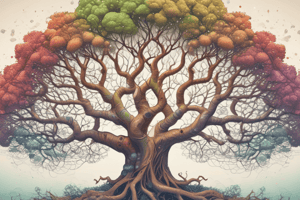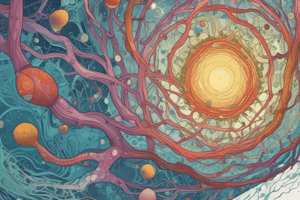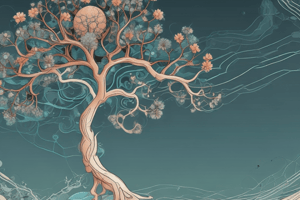Podcast
Questions and Answers
What is the primary focus of the branch of biology known as microbiology?
What is the primary focus of the branch of biology known as microbiology?
Microorganisms, such as bacteria and viruses
What is the main function of the mitochondria in a cell?
What is the main function of the mitochondria in a cell?
Energy production
What is the term for the genetic makeup of an individual?
What is the term for the genetic makeup of an individual?
Genotype
What is the process by which a new species emerges from an existing one?
What is the process by which a new species emerges from an existing one?
What type of organisms produce their own food in an ecosystem?
What type of organisms produce their own food in an ecosystem?
What is the term for the study of the relationships between organisms and their environment?
What is the term for the study of the relationships between organisms and their environment?
What is the molecule that contains genetic information?
What is the molecule that contains genetic information?
What is the term for the process by which an organism becomes better suited to its environment?
What is the term for the process by which an organism becomes better suited to its environment?
What is the primary mechanism by which favorable traits are passed on to the next generation?
What is the primary mechanism by which favorable traits are passed on to the next generation?
Which of the following is an example of macroevolution?
Which of the following is an example of macroevolution?
What is the term for the study of the similarities and differences in body structure among different species?
What is the term for the study of the similarities and differences in body structure among different species?
What is the term for the movement of genes from one population to another?
What is the term for the movement of genes from one population to another?
What is the term for the sequence of fossils found in rock layers, showing a pattern of gradual changes in life forms over time?
What is the term for the sequence of fossils found in rock layers, showing a pattern of gradual changes in life forms over time?
What is the term for the differences in DNA sequences among individuals in a population?
What is the term for the differences in DNA sequences among individuals in a population?
What is the term for a trait that has evolved to improve an organism's survival or reproduction in its environment?
What is the term for a trait that has evolved to improve an organism's survival or reproduction in its environment?
What is the term for a group of organisms that can interbreed and produce fertile offspring?
What is the term for a group of organisms that can interbreed and produce fertile offspring?
Study Notes
Branches of Biology
- Botany: study of plants
- Zoology: study of animals
- Microbiology: study of microorganisms (bacteria, viruses, etc.)
- Ecology: study of relationships between organisms and their environment
- Biochemistry: study of chemical processes in living organisms
- Molecular Biology: study of structure and function of biomolecules (DNA, proteins, etc.)
Cell Biology
- Cell: basic structural and functional unit of life
- Cell Membrane: semi-permeable membrane surrounding the cell
- Cytoplasm: jelly-like substance inside the cell membrane
- Nucleus: control center of the cell where DNA is stored
- Mitochondria: organelles responsible for energy production
Genetics
- DNA (Deoxyribonucleic acid): molecule that contains genetic information
- Genes: segments of DNA that code for specific traits
- Genotype: genetic makeup of an individual
- Phenotype: physical expression of an individual's genotype
- Heritability: ability of a trait to be passed down from one generation to the next
Evolution
- Natural Selection: process by which individuals with favorable traits are more likely to survive and reproduce
- Speciation: process by which a new species emerges from an existing one
- Adaptation: process by which an organism becomes better suited to its environment
- Fossil Record: chronological record of the history of life on Earth
Ecosystems
- Ecosystem: community of living and non-living components interacting in a specific environment
- Producers: organisms that produce their own food (plants, algae)
- Consumers: organisms that obtain energy by consuming other organisms
- Decomposers: organisms that break down dead organic matter
Branches of Biology
- Botany involves the study of plants, including their structure, growth, and evolution.
- Zoology is the study of animals, encompassing their behavior, physiology, and classification.
- Microbiology explores the world of microorganisms, including bacteria, viruses, and other microbes.
- Ecology examines the relationships between organisms and their environment, focusing on the interconnectedness of living and non-living components.
- Biochemistry delves into the chemical processes that occur within living organisms, including metabolism and protein synthesis.
- Molecular Biology investigates the structure and function of biomolecules, such as DNA, proteins, and carbohydrates.
Cell Biology
- Cells are the basic structural and functional units of life, capable of reproducing and responding to stimuli.
- The cell membrane is a semi-permeable barrier that regulates the movement of substances in and out of the cell.
- Cytoplasm is a jelly-like substance inside the cell membrane, providing a medium for cellular processes.
- The nucleus is the control center of the cell, containing the genetic material (DNA) that governs cellular activity.
- Mitochondria are organelles responsible for generating energy for the cell through cellular respiration.
Genetics
- DNA is a molecule that contains genetic information, composed of two strands of nucleotides that encode the instructions for life.
- Genes are segments of DNA that code for specific traits, such as eye color or height.
- An individual's genotype is their unique combination of genes, while their phenotype is the physical expression of those genes.
- Heritability refers to the ability of a trait to be passed down from one generation to the next, depending on the inheritance of genes.
Evolution
- Natural Selection is the process by which individuals with favorable traits are more likely to survive and reproduce, leading to the adaptation of populations over time.
- Speciation occurs when a new species emerges from an existing one, often due to geographical isolation or genetic changes.
- Adaptation is the process by which an organism becomes better suited to its environment, increasing its chances of survival.
- The Fossil Record provides a chronological record of the history of life on Earth, with fossils serving as evidence of ancient species.
Ecosystems
- An ecosystem is a community of living and non-living components interacting in a specific environment, including plants, animals, and microorganisms.
- Producers, such as plants and algae, are organisms that produce their own food through photosynthesis.
- Consumers, including animals, obtain energy by consuming other organisms, while decomposers, like bacteria and fungi, break down dead organic matter.
- The interactions between these components create a delicate balance, maintaining the health and stability of the ecosystem.
Evolution
Understanding Evolution
- Evolution is the scientifically supported theory that all species of life have developed from a common ancestor through the process of natural selection, genetic drift, mutation, and gene flow.
- It is a gradual and ongoing process that has shaped the diversity of life on Earth.
Key Concepts in Evolution
- A species is a group of organisms that can interbreed and produce fertile offspring.
- A population is a group of individuals of the same species living in a specific geographic area.
- Genetic variation refers to the differences in DNA sequences among individuals in a population.
- Adaptation is a trait that has evolved to improve an organism's survival or reproduction in its environment.
Mechanisms of Evolution
- Natural selection is the process by which individuals with favorable traits are more likely to survive and reproduce, passing those traits to their offspring.
- Genetic drift is the random change in the frequency of a gene or a genetic trait in a population over time.
- Mutation is a change in the DNA sequence of an individual.
- Gene flow is the movement of genes from one population to another.
Evidence for Evolution
- The fossil record shows a pattern of gradual changes in life forms over time.
- Comparative anatomy reveals similarities and differences in body structure among different species.
- Molecular biology shows similarities and differences in DNA and protein sequences among different species.
- Biogeography studies the geographic distribution of species, showing that closely related species are often found in the same or nearby areas.
Types of Evolution
- Microevolution refers to the evolution of small-scale changes within a population over a short period of time.
- Macroevolution refers to the evolution of large-scale changes over a long period of time, resulting in the formation of new species.
- Co-evolution is the evolution of two or more species that are closely associated with each other, such as predators and prey.
Evolutionary Theories
- Darwin's theory of evolution emphasizes the role of natural selection in shaping the evolution of species.
- The modern synthesis is the current understanding of evolution, incorporating genetics, ecology, and other fields to provide a more comprehensive explanation of the evolutionary process.
Studying That Suits You
Use AI to generate personalized quizzes and flashcards to suit your learning preferences.
Description
This quiz covers the different branches of biology, including botany, zoology, microbiology, ecology, biochemistry, and molecular biology, as well as the basics of cell biology, including cell structure and function.




